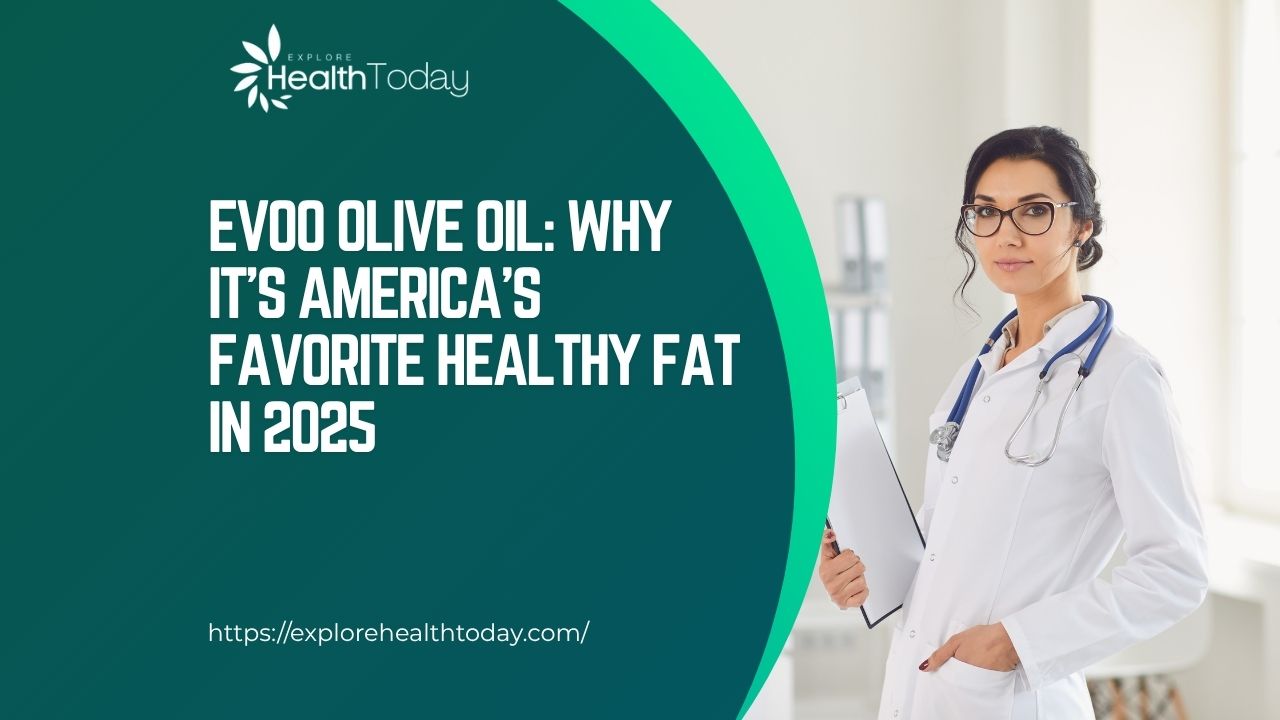Introduction: EVOO Olive Oil—A Staple with Staying Power
If you’ve ever browsed a cooking blog, tuned into a food podcast, or strolled down the oil aisle at your local grocery store, chances are you’ve encountered the term EVOO olive oil. Short for extra virgin olive oil, EVOO has become synonymous with heart-healthy cooking, flavor-rich recipes, and the Mediterranean lifestyle.
In 2025, EVOO isn’t just a culinary trend—it’s a wellness choice backed by science and embraced by health-conscious Americans nationwide. Whether you’re sautéing vegetables, dressing a salad, or dipping crusty sourdough, understanding what sets EVOO apart from other oils can help you make better dietary decisions.
In this article, we’ll explore what EVOO olive oil really is, how it differs from other oils, its health benefits, how to shop for it wisely in the U.S., and why it’s standing strong amid ongoing nutrition debates.
What Is EVOO Olive Oil?
EVOO stands for Extra Virgin Olive Oil, the highest quality grade of olive oil. It’s made by mechanically pressing fresh olives—without the use of heat or chemicals—to extract pure oil that retains all its flavor, nutrients, and antioxidants.
Unlike refined oils, EVOO is unprocessed and comes directly from the first pressing of the olive fruit, making it rich in:
- Monounsaturated fats (especially oleic acid)
- Vitamin E
- Polyphenols and antioxidants
- Anti-inflammatory compounds like oleocanthal
These natural elements give EVOO its peppery flavor, fragrant aroma, and health-promoting qualities.
How Is EVOO Olive Oil Made?
The production process is what defines EVOO and separates it from lower grades:
Cold Pressing Method:
- Harvesting: Olives are picked early in the season to retain more nutrients.
- Washing and crushing: Olives are cleaned and ground into a paste.
- Pressing or centrifugation: The paste is spun to separate oil from water and solids.
- Bottling: The oil is filtered (sometimes left unfiltered for a more rustic product) and stored in dark bottles to protect against light.
To qualify as EVOO, the oil must meet strict chemical and sensory standards. According to the U.S. Department of Agriculture (USDA), extra virgin olive oil must have:
- Free acidity of no more than 0.8%
- No sensory defects (like rancidity or fustiness)
- A positive fruity flavor
Health Benefits of EVOO Olive Oil
Thanks to its natural production and nutrient density, EVOO offers a wide range of proven health benefits:
1. Supports Heart Health
EVOO is rich in monounsaturated fats, which help reduce LDL (bad) cholesterol while maintaining HDL (good) cholesterol. The American Heart Association supports olive oil as a healthier fat alternative to butter or margarine.
2. Fights Inflammation
Its high content of polyphenols, particularly oleocanthal, may offer similar benefits to anti-inflammatory drugs like ibuprofen.
3. Boosts Brain Function
A 2024 review published in the Journal of Nutritional Neuroscience found that diets rich in EVOO are linked to slower cognitive decline and reduced risk of Alzheimer’s disease.
4. Protects Against Oxidative Stress
The vitamin E and antioxidants in EVOO help combat oxidative damage in cells, which plays a role in aging and chronic disease.
EVOO vs. Other Olive Oils
Not all olive oil is created equal. Here’s how EVOO stacks up:
| Type | Processing Method | Nutritional Value | Best Uses |
| Extra Virgin (EVOO) | Cold-pressed, unrefined | Highest (antioxidants, fat) | Dressings, dips, low-medium cooking |
| Virgin | Cold-pressed, minor flaws | Good | General cooking |
| Pure/Light Olive Oil | Refined with heat/solvents | Low | High-heat frying, baking |
| Olive Pomace Oil | Chemically extracted | Lowest | Deep frying (industrial use) |
If you’re shopping for quality and health benefits, always choose extra virgin olive oil.
U.S. Trends: EVOO on the Rise in 2025
Interest in EVOO olive oil continues to grow in the U.S., driven by a surge in clean eating, Mediterranean diets, and distrust of processed seed oils.
Key 2025 Trends:
- Retail Growth: U.S. EVOO sales rose by 11.4% in 2024, according to the American Olive Oil Producers Association (AOOPA).
- Food Labels: More restaurants are advertising “cooked in EVOO” or “EVOO-based dressings.”
- Seed Oil Awareness: Influencers and wellness doctors are promoting EVOO as a healthier alternative to canola, soybean, and sunflower oils.
- Domestic Production: California is now home to over 40 olive oil farms producing award-winning EVOO, helping reduce dependency on imports.
As consumers become more ingredient-aware, EVOO remains one of the few oils trusted across nutrition camps—from keto and paleo to Mediterranean and whole-food diets.
How to Shop for the Best EVOO Olive Oil
Not all “extra virgin” labels are created equal. Here’s what to look for:
Tips for Buying Authentic EVOO:
- Dark glass bottle to protect from light.
- Harvest date (the fresher, the better—ideally within 12 months).
- Country of origin or California Olive Oil Council (COOC) seal.
- Cold-pressed or first cold press listed on the label.
- Avoid phrases like “pure olive oil” or “light tasting” (these are refined blends).
You can verify certification and testing standards through trusted sites like the North American Olive Oil Association (NAOOA).
Cooking with EVOO: Is It Safe for Heat?
Yes, despite common myths, EVOO is safe for most cooking methods.
Smoke Point:
- EVOO: ~375°F–410°F
- Suitable for: sautéing, roasting, baking, and light frying
- Not ideal for: deep frying at extremely high temperatures
Because it’s rich in antioxidants and monounsaturated fats, EVOO is more stable under heat than many people assume.
A 2024 study published in Food Chemistry showed that EVOO retains more nutrients and produces fewer harmful byproducts under heat compared to sunflower or soybean oil.
Easy Ways to Use EVOO Every Day
Looking to add EVOO into your diet? Try these simple ideas:
- Drizzle over roasted vegetables
- Mix into salad dressings with lemon or vinegar
- Use in marinades for poultry or seafood
- Toss with cooked pasta or grains
- Swirl into hummus or dips for extra richness
Common Misconceptions About EVOO
Let’s debunk a few lingering myths:
- Myth: “You shouldn’t cook with EVOO.”
Truth: It’s stable and safe for everyday cooking. - Myth: “It’s too expensive.”
Truth: High-quality EVOO may cost more up front, but a little goes a long way. You’re also investing in your health. - Myth: “All olive oil is the same.”
Truth: Only EVOO is unrefined and nutrient-rich. Lower grades are often chemically treated.
Conclusion: Why EVOO Olive Oil Belongs in Every U.S. Kitchen
From its unmatched flavor to its well-researched health benefits, EVOO olive oil is more than a pantry staple—it’s a smart lifestyle choice. In a market filled with overly processed seed oils and misleading labels, EVOO stands out as a trusted, natural fat that aligns with modern health goals.
Whether you’re a gourmet chef or just looking to eat better in 2025, choosing high-quality extra virgin olive oil is a simple step with big payoffs for your heart, brain, and overall well-being.
Make the switch today—ditch overly refined oils and elevate your meals with real EVOO olive oil. Look for cold-pressed, certified bottles at your local market, and enjoy the rich, clean flavor of nature’s original superfood oil.
About ExploreHealthToday.com
ExploreHealthToday.com was created to be a one-stop resource where readers can find up-to-date, well-researched articles on a variety of health topics. From nutrition and wellness to lifestyle and mental health, we strive to provide reliable information to help you make informed decisions about your well-being.
We believe that good health starts with good information, and our mission is to empower our readers with knowledge they can trust.
Visit us at ExploreHealthToday.com to learn more.





